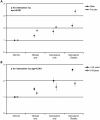Sarcopenic obesity associated with high-sensitivity C-reactive protein in age and sex comparison: a two-center study in South Korea
- PMID: 30232104
- PMCID: PMC6150137
- DOI: 10.1136/bmjopen-2017-021232
Sarcopenic obesity associated with high-sensitivity C-reactive protein in age and sex comparison: a two-center study in South Korea
Abstract
Objectives: To evaluate the association between high-sensitivity C-reactive protein (hs-CRP) and sarcopenic obesity, and to determine age or sex differences underlying the relationship between hs-CRP and sarcopenic obesity.
Design: Observational study.
Participants: The study included 237 838 participants whose body composition and hs-CRP were analysed at the two health promotion centres in South Korea. Participants were divided into four groups based on body composition: normal, obesity only, sarcopenia only and sarcopenic obesity.
Primary measures: The levels of hs-CRP and proportion of participants with high (≥1.0 mg/L) hs-CRP. Sarcopenic obesity was defined as subjects fulfilling the criteria for sarcopenia (below 2 SD of mean of Skeletal Muscle Mass Index for young adults) and obesity (waist circumference ≥90 cm for men and ≥85 cm for women).
Results: The level of hs-CRP was highest in the sarcopenic obesity group. Following adjustment for various confounders including age, sex, comorbidities, metabolic, health-related behaviour and demographic factors, the adjusted ORs (95% CI) for subjects with high hs-CRP associated with obesity, sarcopenia and sarcopenic obesity compared with normal group (reference) were 1.17 (1.05 to 1.31), 2.23 (1.21 to 4.07) and 3.23 (2.71 to 3.83), respectively. In age subgroup analyses, multivariate logistic regression analysis revealed that the association of high hs-CRP with sarcopenic obesity was stronger in younger (<60 years) participants than in older (≥60 years) participants (p for interaction <0.001). In subgroup analyses for sex, the association of high hs-CRP with sarcopenic obesity was higher in female participants than in males (p for interaction <0.001).
Conclusions: This study demonstrated that high level of hs-CRP was independently associated with sarcopenic obesity in Korean population. We found for the first time that there was a strong association between increased hs-CRP and sarcopenic obesity in female and younger (<60 years) subjects.
Keywords: high-sensitivity C reactive protein; sarcopenia; sarcopenic obesity.
© Author(s) (or their employer(s)) 2018. Re-use permitted under CC BY-NC. No commercial re-use. See rights and permissions. Published by BMJ.
Conflict of interest statement
Competing interests: None declared.
Figures


Similar articles
-
Association of Sarcopenic Obesity with Higher Serum High-Sensitivity C-Reactive Protein Levels in Chinese Older Males--A Community-Based Study (Taichung Community Health Study-Elderly, TCHS-E).PLoS One. 2015 Jul 15;10(7):e0132908. doi: 10.1371/journal.pone.0132908. eCollection 2015. PLoS One. 2015. PMID: 26177029 Free PMC article.
-
Gamma-glutamyl transferase is associated with sarcopenia and sarcopenic obesity in community-dwelling older adults: results from the Fifth Korea National Health and Nutrition Examination Survey, 2010-2011.Endocr J. 2015;62(7):585-92. doi: 10.1507/endocrj.EJ15-0119. Epub 2015 May 25. Endocr J. 2015. PMID: 25913781
-
Sarcopenia, sarcopenic obesity and inflammation: Results from the 1999-2004 National Health and Nutrition Examination Survey.Clin Nutr. 2016 Dec;35(6):1472-1483. doi: 10.1016/j.clnu.2016.03.028. Epub 2016 Apr 7. Clin Nutr. 2016. PMID: 27091774 Free PMC article.
-
Global prevalence of sarcopenic obesity in older adults: A systematic review and meta-analysis.Clin Nutr. 2021 Jul;40(7):4633-4641. doi: 10.1016/j.clnu.2021.06.009. Epub 2021 Jun 21. Clin Nutr. 2021. PMID: 34229269
-
Association between sarcopenia with incident cardio-cerebrovascular disease: A systematic review and meta-analysis.Biosci Trends. 2023 Sep 15;17(4):293-301. doi: 10.5582/bst.2023.01130. Epub 2023 Aug 11. Biosci Trends. 2023. PMID: 37574268
Cited by
-
Obesity and COVID-19: A Fatal Alliance.Indian J Clin Biochem. 2020 Oct;35(4):410-417. doi: 10.1007/s12291-020-00909-2. Epub 2020 Jul 10. Indian J Clin Biochem. 2020. PMID: 32837031 Free PMC article. Review.
-
The Association between Obesity and Reduced Weight-Adjusted Bone Mineral Content in Older Adults: A New Paradigm That Contrasts with the Obesity Paradox.Nutrients. 2024 Jan 25;16(3):352. doi: 10.3390/nu16030352. Nutrients. 2024. PMID: 38337637 Free PMC article.
-
COVID-19 and Obesity: Overlapping of Two Pandemics.Obes Facts. 2021;14(6):579-585. doi: 10.1159/000518386. Epub 2021 Sep 24. Obes Facts. 2021. PMID: 34569546 Free PMC article. Review.
-
Association between Elevated Plasma Homocysteine and Low Skeletal Muscle Mass in Asymptomatic Adults.Endocrinol Metab (Seoul). 2022 Apr;37(2):333-343. doi: 10.3803/EnM.2021.1202. Epub 2022 Feb 8. Endocrinol Metab (Seoul). 2022. PMID: 35144330 Free PMC article.
-
Hopeless tooth and less posterior occlusion is related to a greater risk of low handgrip strength: A population-based cross-sectional study.PLoS One. 2021 Dec 23;16(12):e0260927. doi: 10.1371/journal.pone.0260927. eCollection 2021. PLoS One. 2021. PMID: 34941935 Free PMC article.
References
Publication types
MeSH terms
Substances
LinkOut - more resources
Full Text Sources
Other Literature Sources
Medical
Research Materials
Miscellaneous
